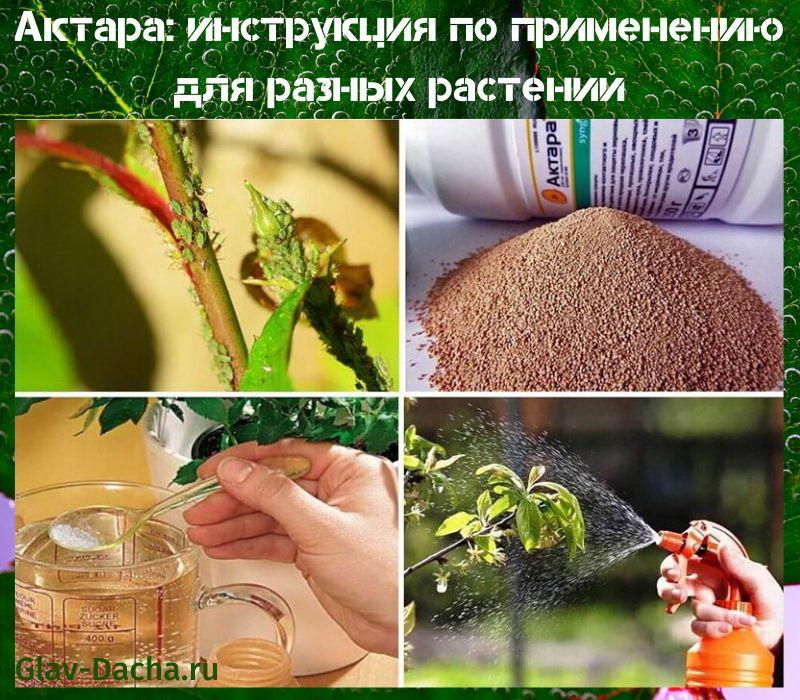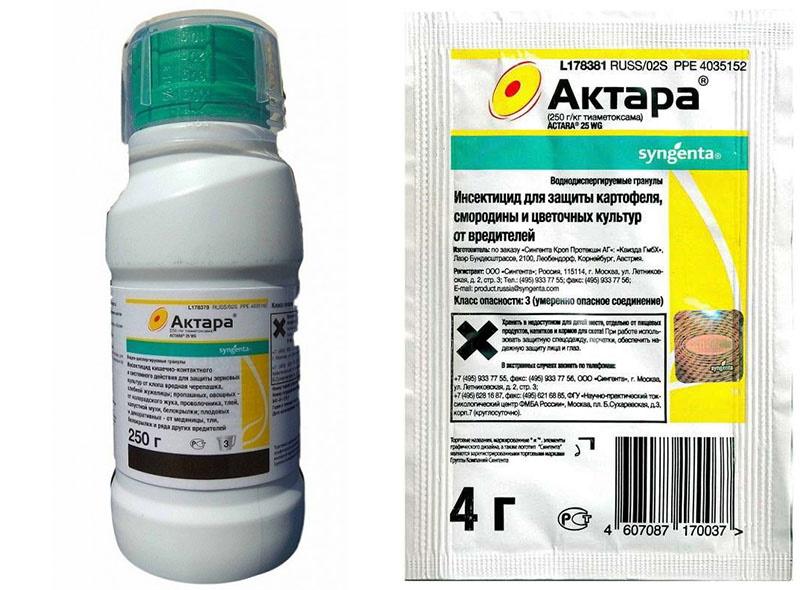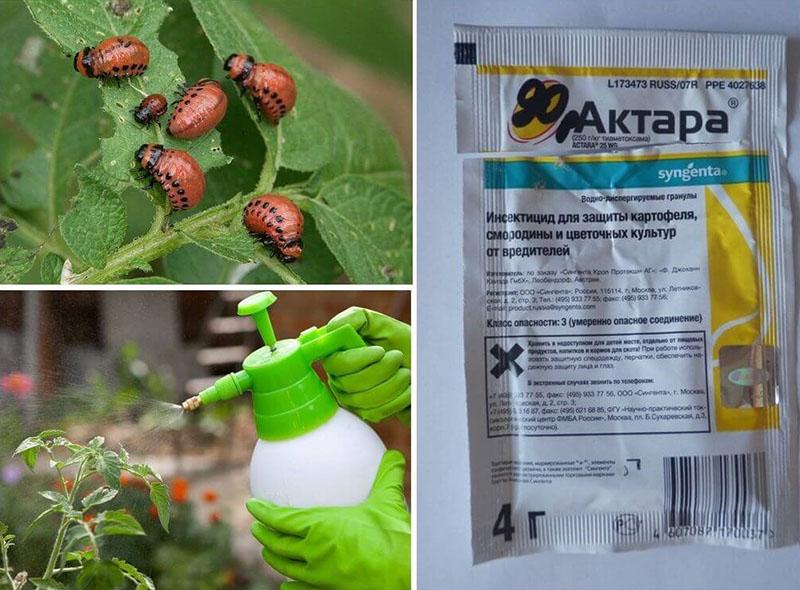Aktara: instructions for use for different plants
 Aktara is a broad-spectrum insecticide used for the rapid destruction of pests and their larvae that parasitize agricultural and fruit crops, ornamental and indoor plants. Aktara, the instructions for use of which are presented below, refers to potent universal insecticides, characterized by high efficiency of systemic action, as well as safety in use if the instructions are followed.
Aktara is a broad-spectrum insecticide used for the rapid destruction of pests and their larvae that parasitize agricultural and fruit crops, ornamental and indoor plants. Aktara, the instructions for use of which are presented below, refers to potent universal insecticides, characterized by high efficiency of systemic action, as well as safety in use if the instructions are followed.
Read the article in the topic: intavir instructions for use in the garden!
Features of the composition and form of release

Aktara is produced in the form of a liquid suspension with an active substance concentration of 25-35%, as well as water-soluble granules for preparing a working solution. Granules are packed in 4 g, 40 g or 250 g sachets.
The average price of Aktara, depending on the form of release and dosage, ranges from 30 to 6000 rubles.
How Aktara works
 The drug is used to combat various pests of garden and vegetable garden crops, fruit trees, shrubs, flowers and indoor plants.
The drug is used to combat various pests of garden and vegetable garden crops, fruit trees, shrubs, flowers and indoor plants.
Aktara is highly effective against more than 100 varieties of pests, which include:
- Colorado beetle;
- scabbards;
- wireworm;
- false shields;
- thrips;
- aphid;
- suckers;
- color beetle;
- onion flies;
- apple moths;
- cabbage fleas;
- spider mite;
- flies;
- worm;
- whitefly.
Aktara refers to insecticidal preparations of intestinal action. When processing crops, the active component penetrates into the layers of the plant, and from there into the gastrointestinal tract of the pest.
The insecticide affects the nervous system of the insect, disrupting the transmission of nerve impulses, causing paralysis and subsequent death. Most often, it occurs 5-6 hours after treatment.
Advantages and disadvantages of Aktara
The tool can be used in two ways - by applying to the soil or by spraying the plants themselves. Aktara has a long-lasting effect. When spraying crops, insecticidal protection lasts up to 3 weeks, when applied to the ground - up to 10-12 weeks.
Also Aktara is often used for preventive dressing of potato tubers and eggplant seedlings, tomatoes and bell peppers before planting in open soil.
The main advantages of Aktara:
- a wide range of action against most garden and garden pests;
- high efficiency and long-term insecticidal effect, which lasts up to 8-12 weeks;
- the absence of a sharp, unpleasant odor, which allows you to use the product in closed rooms for the treatment of indoor plants;
- high resistance to sudden changes in temperature - direct sunlight and rain do not reduce the effectiveness of the drug;
- the active substances contained in Aktar do not accumulate in fruits and do not impair the productivity of plants;
- if the instructions for use are followed, Aktara is completely safe for human health, animals and beneficial insects.
Before treatment with an insecticidal solution, it must be borne in mind that Aktara acts only on adults and has minimal effectiveness against eggs, larvae and pupae of insects.
In addition, with prolonged use, the drug is addictive in pests, which significantly reduces its effectiveness. Therefore, Aktar is recommended to be combined with other insecticides.
Aktara: instructions for use for different types of crops
 The package of the insecticidal preparation should be opened only in an open space, using a respirator and other personal protective equipment. The dosage of Aktara for preparing a working solution, the time when to process crops and processing characteristics depend on the specific type of plants.
The package of the insecticidal preparation should be opened only in an open space, using a respirator and other personal protective equipment. The dosage of Aktara for preparing a working solution, the time when to process crops and processing characteristics depend on the specific type of plants.
Vegetable crops

Aktara is widely used to destroy various pests of garden crops. The proportions for the preparation of an insecticidal solution depend on the type of plant:
- For potatoes - 2 bags of Aktara weighing 1.4 g each must be diluted in 2 buckets of water. When using ampoules of 1.2 ml, 2 buckets of water are taken for each ampoule. A bucket of working solution is enough to treat 200 square meters of land. Processing is carried out once.
- For cucumbers - 2 g of Aktara is diluted in 10 liters of water, the working solution is enough for 200 square meters of the garden. The beds are processed once a week.
- White cabbage - the solution is prepared similarly to cucumbers, the beds are processed by spraying. In case of severe pest damage, the dosage is increased to 3 g of the drug per bucket of water.
For the treatment of bell peppers, eggplants, tomatoes, peas and legumes, the insecticidal solution is prepared from a bag of Aktara 1.4 g and a bucket of water. The processing of garden crops must be carried out once, preferably immediately after the identification of pests.
Aktara: instructions for use for fruit trees and shrubs

Instructions for use Aktara recommends using an insecticidal agent to combat pests of fruit trees and shrubs - apple trees, pears, strawberries, currants, gooseberries.
- apple trees - 3 g of Aktara per 1 bucket of water, treatment is carried out once before or after flowering;
- pears and other fruit trees - 4 g of an insecticidal preparation per 10 liters of water:
- Strawberry, currant - 2 g of the drug per 10 liters of water, the bush is processed before flowering and after harvesting.
The insecticidal agent can be used to treat grapes from leafhoppers and other pests. To do this, dissolve 3 g of Actara in a bucket of water and spray.
Aktara: instructions for use for indoor flowers
 When preparing the Aktara insecticidal solution for indoor plants, you need to open the ampoule of the drug (1.2 ml) and mix it with 10 liters of clean water. This solution is enough to process 100-140 plants.
When preparing the Aktara insecticidal solution for indoor plants, you need to open the ampoule of the drug (1.2 ml) and mix it with 10 liters of clean water. This solution is enough to process 100-140 plants.
Processing is carried out both by spraying and watering the soil.
If indoor plants were sprayed, the room should be left closed for 5-7 hours, if they were watered - at least 2 hours.
After this time, the room should be thoroughly ventilated by opening windows and doors.
Seedling processing
Aktara is an insecticidal preparation that can be used to treat not only plants affected by pests, but also seedlings for preventive purposes. This product can be used to treat potato tubers before planting in open soil.
Method of preparing solution for tomatoes, eggplants or bell peppers:
- 2 sachets of Aktara, 1.4 g each, must be dissolved in 2 liters of heated water;
- vegetable seedlings should be immersed in the prepared solution and left for 2 hours;
- the treated seedlings must be planted in open soil for the next 10-12 hours.
For potato tubers, the solution is prepared in a different way - 6 g of the drug must be dissolved in 500 ml of water, and then poured into a bottle with a spray bottle.
The potato tubers should be spread out on plastic wrap and sprayed evenly with an insecticidal solution. You cannot store vegetables; immediately after processing, they are planted in open ground.
Safety compliance and toxicity
 Aktara belongs to insecticides of the 3rd hazard class, that is, low-toxic drugs.
Aktara belongs to insecticides of the 3rd hazard class, that is, low-toxic drugs.
In order to completely eliminate the risk of intoxication during processing, you must strictly follow the instructions and observe safety precautions:
- Insecticide treatment is carried out only with the use of personal protective equipment - glasses, respirator, protective gloves.
- Spraying indoor plants is carried out in an open space or with open windows.
- After processing, the remains of the working solution, packaging must be disposed of.
 When using Aktara, it is strictly forbidden to drink, eat or smoke. After completing the work, you need to wash your face, wash your hands and open areas of the body with plenty of cool water.
When using Aktara, it is strictly forbidden to drink, eat or smoke. After completing the work, you need to wash your face, wash your hands and open areas of the body with plenty of cool water.
Aktara can be combined with other insecticidal preparations. It can be combined with agents whose action is aimed at destroying insect pests and fungal diseases. Also, Aktara can be combined with drugs that stimulate the growth of garden or garden plants.
The only limitation is considered to be insecticidal preparations and alkaline-based fertilizers. They cannot be combined with Aktara.
Reviews about Aktar
 Reviews of many gardeners and gardeners confirm the high efficiency and ease of use of Aktara.
Reviews of many gardeners and gardeners confirm the high efficiency and ease of use of Aktara.
Tatiana, Moscow: “I noticed that a shield appeared on the indoor violets. The store advised Aktar, as this tool quickly destroys the scale insects and does not have a pungent odor. I mixed 0.5 g with 1 liter of water, poured it into a bottle with a spray bottle and sprayed the plants just in pots. A week later, I poured the soil in flowerpots with the same solution. The result pleased me - the smell is really absent, the violets are healthy. "
Daria, Yekaterinburg: “Last summer I faced such an unpleasant problem as aphids. She occupied the roses in the country. On one of the forums I read about Aktar, prepared a solution according to the instructions and sprayed the flowers. The number of insects decreased significantly within a few hours. The next week I carried out a second treatment - the aphids on the rose completely disappeared. "
Boris, Samara: “I use Aktara for processing seedlings and potatoes before planting in the ground. Used for pest control in the greenhouse. The only drawback of the remedy is the need to strictly follow the instructions and observe the dosage. At first it was difficult to calculate the number of grams and liters of water, then I got used to it. "
Aktara is an effective insecticidal preparation for reliable protection of garden, garden and indoor plants, fruit trees from pests. The product provides a quick and long-term effect and, if used correctly, does not pose any danger to human and animal health, as well as to the future harvest.